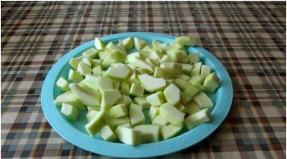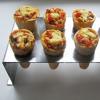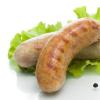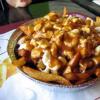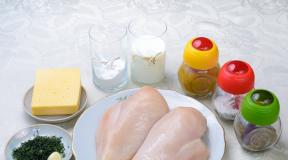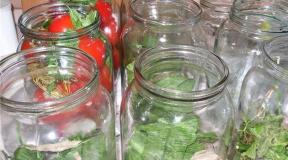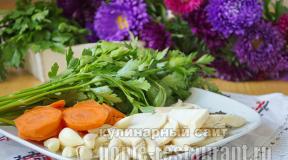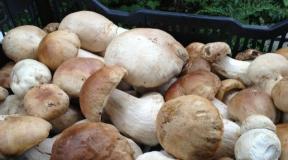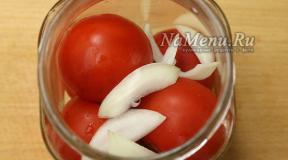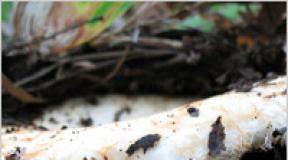How many grams of salt in a tablespoon table. How many grams of salt are in a teaspoon without a slide? How to determine the right amount of salt? Foreign measures of weight
Experienced housewives rarely use a measuring cup or kitchen scale, because everything is done by eye. However, some complex dishes require perfect proportions, such as pastries and desserts. In this case, you can use an ordinary glass or spoon, as our mothers and grandmothers once did. And, by the way, they got the thinnest lacy pancakes, ruddy pies, crumbly biscuits and perfectly baked tender biscuits which were eaten very quickly. Measures for measuring weight at home are simple - a thin and faceted glass, a teaspoon and a tablespoon. Let's talk about how many products fit in these containers.
Measuring food in a glass
The measure of weight in a glass depends on whether you are using a thin or faceted glass, as they are different from each other. The faceted glass has a volume of 200 ml, several edges and a rounded rim. Thin glass - absolutely smooth and designed for 250 ml. Liquids (water, wine, milk, juice, cream) are easy to measure, but bulk products with the same volume have different weights, which greatly complicates the measurement process. This is exactly what a table of measures for the weight of products is needed for - with it you will never make a mistake and measure out exactly as much sugar and flour as is required for a cake or cookie.
Comparing products, we will indicate the amount in a faceted (first digit) and thin glass (second digit). For example, one glass holds 140–175 g of wheat flour, 180–220 g granulated sugar, 190–230 g vegetable oil, 185–240 g melted butter, 250-300 g of condensed milk and 270-330 g of jam. As for cereals, 70–90 g of oatmeal, 170–210 g of buckwheat, 150–200 g of semolina, 190–230 g of rice, peas, beans, millet, barley, barley groats and small pasta. It will fit 130–140 g of crushed nuts, 130–160 whole almonds and hazelnuts, 265–325 g of honey, 210–250 g of sour cream, 250–300 g tomato paste and 100-125 g of ground crackers.
A little about weight measures in a tablespoon and a teaspoon

It is hard to imagine how you can measure five glasses of flour or a liter of milk with spoons, so these cutlery are suitable for measuring a large number of products. For example, if you need just a little flour to make puff pastries, bechamel sauce, vegetable, meat or fish cakes, you can use a teaspoon or a tablespoon.
One tablespoon is 18 g of liquid, 25 g of oatmeal, sugar, semolina, buckwheat, barley, millet and rice. You can fully count on the fact that 17 g of vegetable or melted butter, 30 g of flour, salt and ground nuts, 25 g of sour cream and cocoa powder, 20 g of powdered milk, 30 g of starch and honey will fit in a spoon. You will get only 15 g of ground crackers, but you can scoop up 50 g of jam with a tablespoon. With a miniature teaspoon, you can measure out 10 g of sugar, starch and sour cream, 8 g of flour, 9 g of cocoa, 7 g of honey, 5 g of vegetable oil and milk. A teaspoon also holds 10 g walnut kernels, 17 g of jam, about 5 g of cereals and peas, 2–4 g of cereal flakes.
Accuracy - the politeness of kings

To measure the weight of products without weights, you need to follow some rules that will help you strictly follow the recipe. For the preparation of appetizers, soups, main dishes and side dishes, this is not so critical. However, in some cases, for example when baking bread, the wrong ratio of liquid and flour can lead to a slowdown in fermentation. With a lack of moisture, the dough does not rise well, and the bread has a dry, crumbly texture. If, on the contrary, there is too much moisture, the baking turns out to be heavy, blurry, with a raw and sticky crumb.
We measure products correctly

How to use home weight measures correctly? Liquid products should be filled to the limit, that is, to the very brim. It is more convenient to apply viscous and thick mixtures (honey, jam, sour cream) with a spoon, making sure that the glass is completely filled. Fill containers with loose and viscous products with a slide, and do not scoop flour and starch directly from a bag or bag, but pour it with a spoon so that voids do not form. No need to shake, loosen and tamp the food, and if you need to sift the flour, do it after measuring. The fact is that when sifting, the flour becomes more voluminous, which means that its weight will also change. For comparison, a thin glass contains 160 g of flour when properly filled, 210 g of tamped flour and 125 g of sifted flour. Changing the characteristics of products also affects their weight - for example, an increase in humidity makes salt, sugar and flour heavier, and fermented sour cream is lighter than fresh.
What to replace

If you do not have a tea and faceted glass, take any container, measure its volume with accurate ones and mark the line where the volume will be 200 or 250 ml. AT culinary purposes You can also use standard plastic cups with a capacity of 200 ml. Usually in recipes, instead of the phrase " tea glass” is simply written “glass” or “cup”, which means 250 ml. If a faceted glass serves as a measure of weight, then this will certainly be indicated in the recipe.
Culinary arithmetic

No need to keep dozens of numbers in your head to cook tasty dish and not go crazy with mathematical calculations. It is enough to have a table of weight measures in spoons and glasses in the kitchen. If you see in the recipe an indication to take half or a quarter of a glass of some product, such as sugar, then, having a table, you can easily convert this amount into other measures. For example, a quarter of a faceted glass contains 45 g of sugar, which is 2 tbsp. l. sugar without a slide or 5.5 tsp. Interestingly, 1 st. l. corresponds to 3 tsp, and a dessert spoon is 2 tsp. One thin glass holds 16 tbsp. l. liquid, thick and bulk products.
Foreign measures of weight

If you like to cook according to foreign cuisine recipes, you may encounter unfamiliar weight measures, so this information will come in handy in the kitchen. An American cup is our thin glass, that is, 250g, and an English cup corresponds to 280g. A pint is 470g, an ounce is 30g, and a quart "weighs" 950g.
They say it's a secret culinary excellence is inspiration and precision, so the correct dosage of ingredients is half the success. If you want to make your life easier and keep complicated arithmetic to a minimum, buy a 500 ml universal measuring cup with divisions for liquid and bulk products. Delight your loved ones with delicious food and enjoy yourself!
To accurately determine how many grams in a tablespoon of loose, solid, or liquid food ingredients, you should have at hand a special table that indicates the weight values \u200b\u200bof the most popular products that are most often used in cooking.
To prepare tasty and healthy dishes, you need not only to use quality products, but also accurately observe the ratio of ingredients. But not on every home cooking there are special scales. It is faster and easier to use ordinary tableware, such as a tablespoon, as measuring utensils.
All recipes that are printed in cookbooks or on websites dedicated to cooking contain information about the weight ratio of the ingredients used. Different products can be quickly measured with ordinary tablespoons or teaspoons, knowing how much of one or another food product holds such cutlery.
Such a useful memo should hang in the kitchen of every housewife, helping her quickly measure the exact amount of certain products. This will speed up the preparation of breakfasts, lunches and dinners and improve them. taste qualities. Knowing exactly how much this or that type of food weighs in a tablespoon, even a novice cook will never make a mistake in the dosage.
Different products have different density and different filling, which is reflected in their weight. A tablespoon has long been a universal measure for determining the weight volume, which is not inferior to scales in terms of measurement accuracy. All bulk ingredients are calculated taking into account the natural slide, which is gained during the normal filling of the spoon.
Weight ratio table for a tablespoon
| Name of products | Weight with a slide in g | Weight without slide in g |
| Wheat flour | 30 | 20 |
| Sugar | 25 | 20 |
| Powdered sugar | 28 | 22 |
| Extra salt | 28 | 22 |
| Rock salt | 30 | 25 |
| Baking soda | 28 | 22 |
| Dry yeast | 11 | 8 |
| Cocoa | 25 | 20 |
| Ground coffee | 20 | 15 |
| cinnamon powder | 20 | 15 |
| Crystalline citric acid | 16 | 12 |
| Rice | 18 | 15 |
| Honey | 30 | 25 |
| Granulated gelatin | 15 | 10 |
| Water | 13 | — |
| table vinegar | 13 | — |
| Whole milk | 13 | — |
| Vegetable oil | 12 | — |
| Melted margarine | 12 | — |
interesting! Based on this measure of volume different products, can be weighed quickly right amount recipe ingredients. Precise observance of proportions always has a positive effect on taste and nutritional qualities any dish.
How many grams in one tablespoon
Not only young, but also experienced housewives a tablespoon will help to weigh. How many grams or ml fit in it does not depend on the volume of a tablespoon, which even with its different forms remains the same, but on the type of bulk or liquid products.
They can have different grain sizes and densities, which affects their "fitting" in a tablespoon. Some components of dishes, such as Wheat flour or powdered sugar, have a very fine grinding, so they fit more in a spoon. However, the density of such products is not very high, so they will have a small weight in such a measuring device.
Liquid products also have different densities and viscosities, which affects their weight when used. cutlery as a meter. The hostess just needs to know about it and take with her a summary measuring table using a tablespoon as a measure of weight for various food ingredients, including the most popular products or those that are often used for preparing homemade lunches and dinners.
Without flour, it is impossible to cook pastries, which require a large amount of this bulk product. In this case, a special measuring cup or cup can be used as a measuring container.
A tablespoon will help measure a small amount of flour when you need to cook:
- sauce;
- breading for cutlets or cheesecakes;
- puree soup;
- custard or other dish to which flour is added to thicken.
Manka
Useful and delicious semolina can be cooked correctly only if the exact ratio of milk and semolina is observed. If you can measure the liquid with a glass, then it is not always possible to accurately determine the amount of semolina. Semolina swells strongly in hot milk, and if there is an error in the ratio of products, the porridge turns out to be too thick and not tasty.
If you know how many grams a tablespoon holds semolina, then you can always cook a delicious and hearty breakfast. It is enough to remember that one tablespoon of semolina contains 20-25 g.
If weight butter is used, then cooking with its use will be greatly simplified if you know that in solid form it fits 20 g in a tablespoon, and 17 in melted butter. Knowing how many grams of butter are in a tablespoon, you can quickly calculate it weight for a particular dish.
Sunflower oil
When weighing vegetable oil in this way, it should be remembered that it must be without sediment, otherwise its weight will increase and the ratio of ingredients will be disturbed. You also need to remember that when chilled, its weight decreases, so you should weigh such a product only when it reaches room temperature.
interesting! If ml is indicated in the recipe, then you can make a calculation by counting the ratio of the number of spoons to a faceted glass. In a tablespoon is placed 12 g of an oily product.
Sugar
This product is used as often as salt. Sugar is put in baking, and also added in a small amount to spice up and emphasize brightness. taste sensations in different dishes
- salads;
- gas stations;
- fills;
- pickles and blanks;
- second courses;
- fruit drinks and other drinks.
Salt
Almost all dishes in the cooking process have to be salted. The exact ratio of salt to the volume of the dish will create a bright flavor range, avoiding undersalting and oversalting of food. When weighing such a product, it should be remembered that it has a heavy specific gravity.
In one tablespoon in dry form, it holds 25-30 g. The weight of salt may differ depending on the grinding, which is of the 1st or 2nd type. If a spoon scoops it up with a large slide, then the weight of salt then reaches 30-35 g.
Honey
Unlike other viscous products, honey is heavy in weight. In a tablespoon, its weight is 40 g. To accurately determine the weight, candied honey should be melted in a water bath. This will simplify the calculation of the amount of its weight when cooking. confectionery and other dishes that require its use.
interesting! Honey is one of the few products that is always measured only in spoons, since when weighed on a scale, it remains on the walls of the dish, which is placed on the weighing platform.
Vinegar
Vinegar is added to sauces salad dressings, when preparing marinades and canned vegetables, as well as for extinguishing soda when preparing dough. It holds 10 g in one tablespoon. When taking measurements, you need to pay attention to the concentration of this product, which can be from 6 to 9%.
Other products
Measuring the weight of ingredients when cooking with a tablespoon will allow beginners and experienced housewives to create not only delicious, but also healthy meals. You can measure other products with such a cutlery, knowing what it includes with a slide:
- cocoa - 30 g;
- gelatin in granules - 15 g;
- water - 12 g;
- rice - 17 g;
- dried yeast - 11 g;
- medium grinding coffee - 20 g;
- cow's milk - 13 g;
- cinnamon powder - 20 g;
- ground nuts - 12 g;
- dry grass, tea - 6 g;
- raw herbs - 10 g.
Secrets of weighing products without scales
cook Tasty food it will be easier without using a kitchen scale, knowing average weight a number of products. The indicators are as follows:
- small egg- 50-55 g;
- yolk - 15 g;
- protein - 35 g;
- regular chicken egg - 55-65 g;
- large chicken egg - 65-70 g;
- medium potato tuber - 150-200 g;
- medium onion - 150 g;
- small garlic clove - 5 g.
Conclusion
When using cutlery to calculate the weight of the ingredients specified in the recipe, it should be borne in mind that the volume of glasses and spoons may vary slightly depending on their shape and size, so they can fit different amount products. If you need to make accurate calculations, you can purchase culinary measuring bowls and scales in specialized stores.
In order to find out how many grams of sugar are in 1 tablespoon, it is not necessary to climb into the cabinet for kitchen scales or memorize the information. Sugar, as well as other bulk products, weigh about the same.
Spoon sizes, their capacity
- a tablespoon - meaning standard, 7 cm - length and 4 cm - width - holds 20 g (without top) or 25 g (with top) of granulated sugar;
- in a smaller spoon, 5 cm long and 4 cm wide, fit 10 and 15 g of this sweet product without a slide and with a slide, respectively.
It turns out that not all devices are the same? For the sake of interest, you can measure your devices, suddenly you will make a mistake by applying granulated sugar with them.
Determine the number of spoons by weight of the product
Many housewives use a measuring spoon. It is more accurate than usual, as you can swipe your finger and pour a perfectly even amount of product without a slide.
But what if you need to find out: 50, 100, 150, 200 grams of sugar is how many tablespoons? 100 grams of sugar is contained in half a faceted glass, but if you don’t have it, then you can get by with a spoon. They will need:
- 2.5 incomplete or 2 filled is 50 g;
- 5 incomplete or 4 filled equals 100 g;
- 7.5 incomplete, 6 filled - 150 g;
- 10 incomplete or 7.5 filled equals 200 g.
Note that 7.5 scoops and full scoops differ by 50g and may introduce an error in accuracy. For 100 and 200 g, it is more convenient to measure sugar with a spoon without a mound, and for 50 and 150 g - with a mound.
How many grams of sugar, salt and other products in a tablespoon
Bulk products vary slightly in weight, they are all about the same. The lightest of the products is wheat flour, which weighs only 10 g, and the heaviest - salt which weighs 25 g.
It is worth noting that usually the value is given in full tablespoons, that is, with the top. The list below shows the maximum values.
For dry food:
- sugar (sand) - 25 g;
- powdered (sugar) - 25 g;
- table salt - 30 g;
- white rice - 25 g;
- wheat flakes - 9 g;
- oatmeal - 14 g;
- white flour - 10 g;
- barley groats - 20 g;
- millet - 25 g;
- barley - 25 g;
- semolina - 25 g;
- buckwheat - 25 g;
- dark raisins - 25 g;
- hercules - 12 g.
For liquid food:
- table vinegar 15% - 15 g;
- tomato paste - 30 g;
- rustic sour cream - 25 g;
- cow's milk - 20 g;
- condensed milk - 30 g;
- honey bee - 35 g;
- melted butter - 17 g;
- melted butter - 20 g;
- olive or sunflower oil - 17 g;
- ordinary water - 18 g;
- berry or fruit jam- 50 g.
It should be noted that not all liquid and viscous products you can put a full tablespoon, for example, butter or condensed milk. In this case, by default it is considered that the device is not completely filled.
In the table below you can see how many grams of sugar and other products are in tablespoons of different sizes:

Usually sugar in the recipe is indicated in grams. It is more convenient, of course, to use a kitchen scale, but if they are not available, a glass or a teaspoon can be a good substitute.
There are several options for measuring:
- To weigh the product with a glass, you need to decide which glass it is. If faceted with a rim, then 250 g will enter it, if without a rim, then only 200;
- A tablespoon holds 25 g. Dessert - 10 less than a tablespoon, 15 g. The most inconvenient thing to measure, of course, is a teaspoon - it contains only 7 g.
So, correctly pouring the number of grams of dry foods with a glass or spoon is not as difficult as it seemed. All this utensils contain a weight that is quite convenient for counting. Perhaps someday you will be able to pour the right amount of granulated sugar by eye when preparing a dish.
We measured the weight of the "kitchen rock salt » GOST R 51574-2000 grade one. It is produced from the salt deposits of the ancient sea "created over millions of years by nature itself."
In other words, we took ordinary cheap coarse salt , which by default is implied in various culinary and other recipes.
Cheap salt often cakes, forming strong lumps that greatly affect weight. Experimentally, we found out that when dosing salt with a glass or spoon, you should definitely crush lumps with a diameter of more than 5 mm, otherwise the real weight will be more than indicated on the site.
How much does a spoon or glass of salt weigh?
Tea room with a slide
Tea spoon salt " with a slide» weighs 12 gram.
To get that much salt in a teaspoon, you need to scoop up greedily, and then shake off the excess that threatens to fall.
Usually, after scooping, salt has the form of a very steep and crumbling rock, which greatly changes its height and, therefore, its mass from scooping to scooping. It is this “changing” rockiness that should be shaken off or cut off, leaving a gentle and neat hill, as in the photo.
Tablespoon salt with a mound» weighs 21-22 grams.
To collect so much salt in a tablespoon, you need to scoop up and then shake off the excess to such an extent that this spoon can be comfortably carried from room to room without spilling a crumb.
All cooking recipes always indicate how much salt to add so that the dish is not too salty or, conversely, undersalted.
It is not always convenient to weigh salt on a kitchen scale, especially when you cook quickly and don’t really want to bother with weighing. In such situations, an ordinary tablespoon will come to your aid, which will very actively serve as a measuring tool.
At the same time, she will measure you salt and other bulk products with a certain accuracy.
Correct spoon
100 grams of salt - how many tablespoons is that? So many housewives ask, because it is much more convenient to measure salt in the kitchen with a spoon than on a scale. Do not forget that spoons are the same different sizes, although they are all approximately similar in volume. So, to answer the question: "100 grams of salt - how many tablespoons?" Let's first define the unit of measure.
We take a standard tablespoon with its length working surface 7 cm and 4 wide. Exactly 25 grams of salt without a slide is placed in such a spoon. So, if we need 100 grams of salt, how many tablespoons will we need? That's right, four.
If you decide to take a spoon with a slide, then the weight of the contents will increase slightly. 30 grams will already fit in a spoon. Thus, 100 grams of salt in heaping spoons is three whole and a third of another tablespoon.
And in glasses?
Sometimes you need to use a large amount of salt, for example, to prepare a marinade, to large seams vegetables for the winter, for preparing a large amount of dishes, for pickling cabbage, and so on. It will be difficult to measure salt with tablespoons all the time.
Then the most ordinary glass will come to the rescue. 100 grams of salt - how much will be in a glass? But now there is a great variety of this dishes, all glasses are different both in height and in volume. Therefore, we take as a sample an ordinary faceted glass, which is now sold in any glassware store.
If the salt is filled to the very top, then exactly 320 grams of salt will enter such dishes. If you fill the glass to the upper belt, the weight will be slightly less - 290 grams.
Thus, if you need to determine how much 100 grams of salt is in glasses, then it is enough to fill one third and you will get the desired result.
By the way, one faceted glass contains a little more than 10 tablespoons of salt with a slide, it is easy to remember: 1 glass - 10 spoons.
on this topic
Tea helpers
We have already determined: to gain 100 grams of salt, how many tablespoons we need. What if you need less? Or, suppose there is no tablespoon at hand, but only tea and dessert ones. I wonder how much salt will fit in there?
We are pleased to reveal to you this secret - exactly 7 grams without a slide and 10 - with a slide. It is easy to remember these indicators: with a slide, three times more salt is placed in a tablespoon than in a teaspoon. That's all the simple math.
Indicators dessert spoon are as follows: without a slide 14 grams, with a slide - 20.
How many other products?
Surely inquisitive housewives will also be interested in the question, but how to count other bulk products - cereals, flour - with spoons? Let's satisfy that curiosity.
A tablespoon of water includes 18 grams, flour - 10 (with a slide - 15), sugar, respectively, 20 g and 25. Dried herbs are placed in one tablespoon in the amount of 5/10 grams, and finely chopped greens - 10/15 grams.
Vegetable oil in a tablespoon will fit 17 grams (with a slide to dial it, whatever one may say, will not work), and milk - 20 grams.
Here indicators are given taking into account the fact that all bulk materials - salt, sugar, cereals, flour - are in a dry state. If salt or sugar gets wet, absorbs moisture, then their weight will be somewhat larger. Do not forget about these nuances, and also remember that due to the peculiarities of the sizes of spoons and glasses, the weight of bulk products can vary plus or minus 1-2 grams.
Have fun in the kitchen!
For those who are fond of cooking or just often cook food, it is important to know how many grams or milliliters of oil fit in a glass, tablespoon or teaspoon. For example, those who love to bake cannot but worry ...
Food and drink
100 grams of vinegar is how many tablespoons? Tableware for measuring weight
Often for cooking delicious food you need to follow the recipe exactly. Unfortunately, this is not always possible, as kitchen scales may not be available. Vinegar is an ingredient in many dishes, in…
Food and drink
Every housewife needs to know this: how many grams of salt are in a tablespoon?
When preparing new dishes, each of you has definitely come across a situation where you need to accurately measure the amount of certain ingredients. Very often in recipes, and indeed in any cooking instructions, yes ...
Food and drink
50 grams of vinegar is how many tablespoons: measuring table and features
Quite often, in the recipes for culinary novelties that lovers of experiments would like to pamper their family and guests, there is a dosage of 50 grams of vinegar. How many tablespoons is that? This question is not of interest...
Food and drink
Rice: “100 grams is how much?” or “Spoons and glasses are used”
You decide to cook something delicious. We looked into all the most interesting culinary publics, chose the most appetizing dish, made a list of products to buy, went to the store, and finally get started ...
Food and drink
How much is 100 grams of sugar? How easy is it to measure them?
Sugar is one of the most common products, without the use of which not a single day can do. housewife(with the exception of those who have limited the use of granulated sugar or completely abandoned it). …
Food and drink
How many grams in a tablespoon of flour, and how to measure flour without weights?
Everyone knows that main secret successful dishes is in the right way…
Food and drink
How to find out: how many grams of flour in a tablespoon
Modern cooking is replete with recipes that often indicate a very precise amount of different products: dry bulk - in grams, and liquid - in milliliters. However, not every hostess has a kitchen…
Food and drink
How many grams of soda in a tablespoon, or How to do without culinary scales
Every housewife has used soda at least once in her life. And very often it happens that there are no culinary scales at hand, and it is extremely important to know how many grams of soda in a tablespoon. It is for such situations that our article was created ...
Food and drink
How much protein is in milk (per 100 grams). How much protein is in powdered milk
A healthy lifestyle is victoriously striding around the planet. If earlier the so-called “heroin chic” was in favor, now preference is given to healthy body, since only in it, according to the Latin popular expression, ...
Source: http://monateka.com/article/61463/
How many grams of salt in one tablespoon and teaspoon, in one glass of 200 and 250 ml: weight table in tablespoons and teaspoons. How many teaspoons and tablespoons are in a glass and a faceted pile of salt? 100 grams of salt: how many tablespoons and teaspoons?
How many grams of salt are in a teaspoon and a tablespoon, a pile, a faceted glass.
Salt is the most sought-after seasoning on the kitchen table. If several centuries ago it was used mainly as a preservative, today salt is added to 90% of prepared dishes.
It is not surprising that in almost every recipe it is necessary to measure a certain amount of grams of salt, which is not always convenient in everyday life, and sometimes there are no scales at hand, and in recipes, salt is most often indicated in grams.
Our grandmothers and mothers did very well without electronic scales, and thanks to the simplest knowledge, you will be able to measure without difficulty in the future. required amount grams of salt for preservation and cooking.
How many grams does a tablespoon and a teaspoon of salt weigh?
Interested in how many grams are in a tablespoon and a teaspoon of salt? It's simple, look at our plate.
*table shows average values
Also consider the grain size of the salt. The finer the grinding, the more difficult it is to get a large slide, therefore, in the finest grinding in a tablespoon with a slide there will be about 28 grams, and in coarse grinding all 35 grams.
How many grams does a tablespoon and a teaspoon of salt weigh?
By the way, it is worth noting that when weighing on a scale, it is sometimes difficult to achieve the exact mass of salt, since salt absorbs moisture very strongly, and the same amount of salt in a dry and humid room will weigh differently. And since conservation is most often done in August-September (with high humidity), many housewives trust spoons more than scales.
How many grams of salt are in one glass of 200 ml? How many grams of salt are in one faceted glass of 250 ml?
Sometimes recipes do not prescribe the number of spoons, but for example a glass of salt. Please note that there are glasses of both 250 and 200 grams, in old Soviet books a glass of 200 grams is indicated, but in the new literature 250 grams are most often mentioned. But it is best to find an annotation to the cookbook, where such nuances should be indicated.
Correspondence table for coarse salt in a glass
Correspondence table for fine grain salt in a glass
How many teaspoons and tablespoons are in a glass of salt?
In order to give an accurate answer how many lies are contained in a glass of salt, you need to know how many grams are in a glass and the grain size of the salt. But it is very easy to calculate using the above tables. For example, 200 gram glass, coarse salt, to the edge. 280 grams / 20 grams (average level tablespoon) = 14 level tablespoons.
How many teaspoons and tablespoons are in a glass of salt?
Now we will make the same calculation for a teaspoon. 280 grams / 7 grams = 40 level teaspoons in one glass.
How many teaspoons and tablespoons are in a faceted stack of salt?
It is also important to know how much salt is in a faceted pile, and also with a decrease in the calculation of a dish - how many tablespoons and teaspoons of salt are in a faceted pile.
So, the classic Soviet stack is 100 grams, but 110 grams of salt is placed in it on average.
One stack contains 5.5 tablespoons without a slide of salt, and 16 teaspoons, also without a slide.
100 grams of salt: how many tablespoons and teaspoons?
And sometimes it becomes necessary to measure 100 grams in tablespoons or teaspoons.
100 grams of salt is 5 tablespoons without a slide, and 14 teaspoons also without a slide.
Salt weight table in tablespoons and teaspoons, piles and glasses
In order to quickly measure the required amount of salt, we provide another table.
How many teaspoons and tablespoons are in 50 g of salt?
In canning, you will find many recipes where you need to put 50 grams of salt on a can of preservation. But not everyone has faceted stacks or measuring cups at hand.
So, 50 grams of salt is one tablespoon with a slide + a spoon without a slide, or 5 teaspoons with a slide.
We hope that our article has answered all your questions, and for the sake of completeness, we present one more plate in which the weight of salt in a particular container is signed.
| Salt in grams | Number of tablespoons and teaspoons |
| 160 grams | 5 canteens with a slide + 1 tea with a slide |
| 150 grams | 5 canteens with a slide |
| 140 grams | 4 canteens with a slide + 1 canteen without a slide |
| 130 grams | 4 dining rooms with a slide + one tea room without a slide |
| 125 grams | 4 canteens with a slide + 1 part-time tea |
| 120 grams | 4 canteens with a slide |
| 110 grams | 3 canteens with a slide + a canteen without a slide |
| 100g | 3 canteens with a slide + tea with a slide |
| 90 grams | 3 canteens without a slide |
| 80 grams | 2 dining rooms with a slide + a dining room without a slide |
| 60 grams | 2 canteens with a slide |
| 50 grams | 1 dining room with a slide + a dining room without a slide |
| 45 grams | 1 canteen with a slide + 1 incomplete |
| 40 grams | 2 canteens without slides |
| 35 grams | 1 dining room with a small slide + one tea room with a slide |
| 30 grams | 1 dining room with a slide |
| 25 grams | One dining room with half a slide |
| 20 grams | One canteen without a slide |
| 15 grams | One tea with a slide + one incomplete tea |
| 10 grams | Tea room with a slide |
| 5 grams | 2/3 tea |

